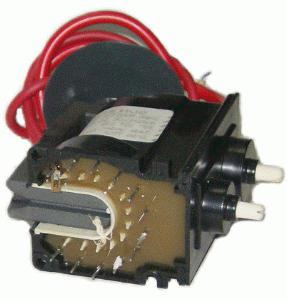In order for the image to appear on the kinescope screen and the viewer to be able to enjoy their favorite shows, it is necessary to direct an electron beam that runs around its entire area. The principle of operation of a monitor or TV, on which the cathode ray tube serves as the displaying element , is easier to describe on the example of black and white equipment.
So, the image on the screen is formed by only one point, with a high frequency running around hundreds of lines. We see the big picture because of the inertia of the organs of our vision.
In addition, in order for the image to be dynamic, a frame change is also necessary. The electron beam runs line by line from top to bottom and returns again because it is driven by a magnetic field created by the windings of the deflecting system. In order for this to happen, it is necessary to change the current in it with a certain regularity.
The classic TV circuit includes various nodes: power supply, horizontal and vertical scanning, a radio channel, a control unit, a low-frequency amplifier and a color module, if the receiver is color. The main element of the horizontal block is the horizontal transformer. In modern televisions, it is usually combined with a voltage multiplier. Its purpose is to obtain sawtooth pulses of electric current, which are fed to the windings of the deflecting system. The voltage multiplier mounted in the same housing as the line transformer creates a high, up to 27 kilovolt, accelerating voltage, which ensures the acceleration of electrons in their movement to the screen mask coated with a phosphor. It, in turn, is fed to the kinescope by means of a high-voltage insulated input with the so-called "blotch", which protects the contact from breakdown on the housing.

The horizontal scanning transformer mounted together with the multiplier (TDKS) has several windings that form additional control signals. These include adjustable focusing and the magnitude of the accelerating voltage, as well as the damping windings of the reverse beam, which should not be visible on the screen.
So, two groups of windings of the deflecting system provide a scan of the raster vertically (personnel, CR) and horizontally (lowercase, SR). As a result, its shape is very close to rectangular, but does not quite correspond to it. This deviation is due to the difference in distance that the electrons have to overcome on the way to the mask. The closer to the edge of the screen, the larger it is, and CRTs with flat screens suffer from this defect to a greater extent than their “convex” counterparts. A line transformer in combination with a multiplier and a deflecting system are an object of careful regulation and tuning, after which the distortions become minimal.
The quality requirements of the TDKS are very high, the duration of proper operation of the entire television receiver depends on it. Line transformers are structurally made in the form of an assembly flooded with a compound and cannot be repaired, so all internal contacts between the windings must be very reliable.
The SR node consumes most of the energy consumed by the TV, up to half of its entire value.
Like any inductive device, a line transformer has a magnetic circuit serving as a rod on which coils are worn. In order to reduce the size, it is made of a special ferrite with high magnetic conductivity.
For all these reasons, TDKS is the most expensive spare honor after a kinescope, the need for which can arise when repairing a TV.